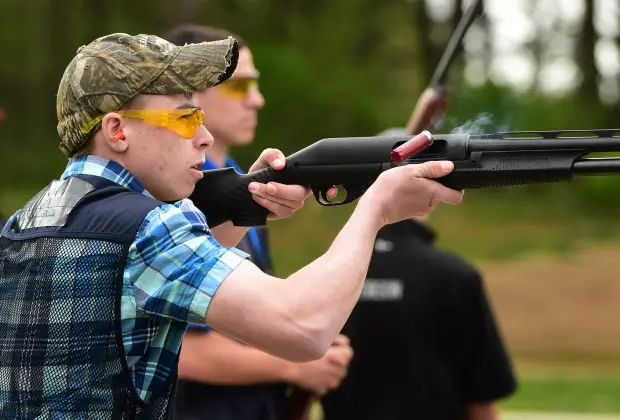Sporting clays is a discipline of the larger sport of clay pigeon shooting.
Clay pigeon shooting involves using a firearm, usually a double-barreled shotgun, to shoot and hit specially-made clay targets (clay pigeons) at close ranges. Clay pigeon has a wide number of disciplines, actually more than 20, of which sporting clays is one.
Sporting clays has a number of sub-disciplines, including the English Sporting Clays, which is the most followed clay shooting sport in the world. Other sub-disciplines within sporting clays include international (FITASC) sporting, Compak sporting, and super sporting sports trap. Skeet shooting is a popular variation of clay pigeon shooting that most people have heard of.
Sporting Clays Facts for Everyone
The sporting clays are a form of pigeon clay shooting that player refer to as “golf with a shotgun” among many. That is due to the way the game is laid out. There are 10 to 15 different shooting stations spread out over a natural course, that most of the time takes place on no fewer than 35 acres of land.
The sport uses clay targets, flying at a wide range of elevations, angles, speeds, trajectories, and distances. The various directions simulate real-life live quarry situations that one may encounter while hunting on sporting “stands.” These clays simulate animals such as bolting rabbits, dropping ducks, springing teal, and flying pheasant in the action of this sport.

During a game of sporting clays, the shooters make their way through a 10 to 15 station course. Each of these stations involves the shooting of 6 to 10 targets, with the launch of 50 to 100 targets in every game for each shooter. Targets launch in pairs and may simulate conditions such as coming inward, crossing from either side, rolling on the ground, flying upwards, thrown from towers, or arcing in the air.
The courses for clay sporting are not the same as a skeet shooting range, which is very popular.
Equipment for Sporting Clays
Sporting clays requires certain equipment for play to take place. There are many levels of play for shooters across the world. It runs from amateurs practicing on makeshift terrain with handheld target throwers, to professional competitions. There are even Olympic games, which hold some clay shooting events during the summer games.
In all of the different types of play involving the clay shooting sports, everyone uses the same equipment, including firearms, target throwers, and clay targets. Let’s take an in-depth look at some of the equipment used in this wonderful sport.
1. Guns
In almost all of the sporting clays, usually, a double-barreled shotgun is the preferred firearm for most situations. There are several types of double-barreled guns most commonly used. The most used guns include the “over-and-under” and “side-by-side” shotguns.
The over-and-under shotgun features two barrels, one placed on top of the other vertically and aligned horizontally to form two barrels, with a top barrel and a bottom barrel. The side-by-side shotgun also has two barrels, but are next to each other horizontally, forming a left barrel and right barrel arrangement.
2. Clay target throwers
Using a target thrower, called a “trap,” with a target holder (house), clay targets launch by remote control or by the sound of someone’s voice.
Some of these machines can be hand-loaded, hand-cocked, and hand-released and are relatively inexpensive. There are other models, however, that are highly sophisticated. There are rotational, spring-loaded flywheel devices that run by computer monitoring for accuracy in scoring. You typically see these high-tech machines in professional level trap throwers for the Olympic games.
These machines are fully automatic and can hold up to 600 individual clay targets at a time. They release or launch clays using electrical or pneumatic machinery.
3. Clay targets
For sporting clays, they use many different types of clay targets. These range from mini clay targets, only 60 mm (millimeters) in diameter with a height of 20 mm, to the standard and battue clay targets ranging from 108 to 110 mm in diameter with a height of 25 to 29 mm in height.
They can also use ZZ targets and others, which have two propellers attached to them and cause irregular, unpredictable flight patterns during competition. That puts the shooter’s skills to the test.
If You Are Interested in Competing
If you are interested in clay shooting and want to become a player who competes — you can. Choose local, regional, national or international level and contact the National Sporting Clays Association for more information. The same resource will answer your questions if you want to play other forms of the clay shooting sports. They’ll also help you find skeet shooting events near you.
Remember that at all times, safety is a priority. Have fun competing, but always follow basic gun safety rules.